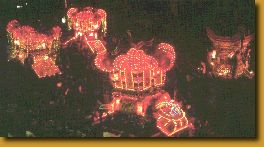|
| TRIP OUT TOP | To the untrained eye, Ehime and Aichi prefectures are frequently confused if only because they share the same first kanji in the names of the prefectures. The first kanji in Ehime is the same as Aichi so the second one is crucial. Get them sorted before you embark on the train for Ehime, one of the prefectures (before 1873 known as Iyo Province) in Shikoku Island, via Onomichi. Then take the boat to Omishima Island (reached in half an hour by hydrofoil from Onomichi on Honshu) where Oyamazumi Shrine was a popular place to worship for emperors and shoguns. It seems that 80 percent of the armor designated as a national treasure or an important cultural property in the country is the property of this shrine. The ferry takes you to Imabari, from where you can either take the JR Yosan Line along the north coast to Saijo, Niihama and Iyomishima, or the west coast journey down to Matsuyama, Ozu and Uwajima.
|
 How
to get there:
Tourist
Info: ¥ Saijo City Sightseeing Association (Saijo-shi Kanko Kyokai) (0897) 56-5151. ¥ Niihama Tourist Section (Niihama-shi Sangyo Shinko-bu Kanko Bussan-ka) (0897) 65-1261. ¥ Iyomishima City Sightseeing Association (Iyomishima-shi Kanko Kyokai) (0896) 24-3555. ¥ Uwajima City Sightseeing Information Center (Uwajima-shi Kanko Joho Center) (0895) 22-3934.
|
|
|
Saijo is located about 50 km from Matsuyama and has a population of some 60,000. It is also a getaway to the Ishizuchi Quasi-National Park which is located about 30 km southwest of Saijo. Mt. Ishizuchi (1,982 m) is the highest peak in Shikoku and also in all western Japan. It takes about three hours to climb to the summit from the terminal of the ropeway. In the old days, the mountain was the site of pilgrimages to the popular Ishizuchi Shrine Main Hall at the base, Joju Shrine in the middle and Chojo Shrine at the peak. A bit further to the south is Omokogei Gorge. During the Saijo Festival, about 130 gorgeous floats (danjiri), o-mikoshi portable shrines and floats carrying musicians (taiko-dai) get together at Kamo Jinja Shrine Oct. 9 & 10, at Iwaoka Shrine Oct. 14 & 15, at Isono Shrine Oct. 15 & 16 and at Iizumi Shrine Oct. 16 & 17. Niihama is a fair-sized town with a population of 140,000, but as many again come to see the festival. The town used to be one of the most prosperous trading ports in Shikoku, due in part to the Besshi Copper Mine, opened by the founders of the Sumitomo family in 1691. The Besshi Mine was closed in 1973 but the area is still an important base for Sumitomo Metal Mining Co. Niihama Taiko Festival is one of the three largest in Shikoku. Elaborate embroidered gold and silver floats (taiko-dai) are over 5.4 m high, 11 m long, and 3.4 m wide. Since each weighs more than 2.5 tons, about 150 bearers, called kakifu, are required to carry them. In 1970 this festival took part in Osaka Expo 1970, and in 1993 went to represent Ehime Prefecture in Singapore. Many pulp, paper and paper processing factories are scattered about in Iyomishima, a small town with a population of 40,000. Mizuhiki, decorative strings made of Japanese paper for tying presents, are a specialty. The area features Lake Kinsha, Iyomishima Shrine and Sankakuji Temple, the 65th station on the 88-Temple Pilgrimage in Shikoku, which can be reached by bus in 35 min. from JR Kawanoe Station and a stiff 45-min. walk. It is believed that worshipping at the temple will ensure safe childbirth. Its autumn festival with o-mikoshi and taiko-dai is spectacular. Matsuyama, the capital of Ehime Prefecture, is a castle town dating back to 1602. It's the birthplace of many modern haiku poets such as Masaoka Shiki (1867-1902) and Takahama Kyoshi (1874-1959). Its Doogo Spa is one of the three oldest in Japan, dating from the 8th C., and is famous for Iyo-kasuri, a type of woven cotton cloth with splashed patterns. Its main building (there are like 200 ryokan there) is a wooden building built in 1891 which is crowned by a drum tower called Shinrokaku. Its annex called Yushinden was added for the visiting members of the Imperial family. Ozu, 56 km southwest of Matsuyama in the Ozu Basin, is enclosed on all four sides by mountains. Since it also features the Hiji River running through the city, it is called "Little Kyoto of Iyo Province." Uwajima,
reached in 1 hour and 45 min. from Matsuyama, was from the 16th C. through
to the early Meiji Era (1870s) a castle town, as well as a cultural and
industrial center. Today it's a port town with a fishery, the processing
of marine products, mandarin orange cultivation and dairy farming providing
the main industries. Uwajima Castle has a three-story 17th C. donjon.
Uwajima's first daimyo, or feudal lord, got the idea for the Yasshika (Eight Deers) Odori Dance from Sendai's Shishi Odori Dance. Ushioni (Ox-Devil), a 5.5 m ox-monster with lacquer-carved head, is believed to have been built by the famous or infamous General Kato Kiyomasa (known as Seisho) to suppress his enemies. Yasshika and Ushioni are both featured on Oct. 29 at the autumn festival at Uwatsuhiko Shrine.
|

